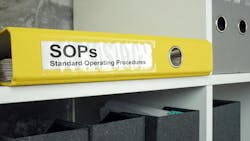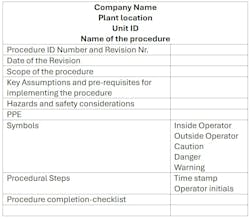Avoid the Next Disaster with Smarter Operating Procedures
What You’ll Learn
How to Align Procedures with Risk
Learn why tailoring operating procedures to process risk — using principles like ALARP — helps prevent major accidents and improves safety.
How to Improve Clarity and Reduce Operator Error
Get tips on writing clear, step-by-step instructions that minimize misinterpretation and account for training gaps among operators and contractors.
How to Maintain and Digitize Procedures Effectively
Understand how to transition to digital formats, manage revisions, and ensure procedures stay up to date with evolving equipment and regulations.
Astute managers, engineers and training professionals recognize the importance of well-written and managed operating procedures in reducing safety risk and enhancing productivity. Process hazard assessments (PHA) assign appropriate safety credits to operating procedures after a careful review of relevant procedures.
There are many types of operating procedures, including equipment startup, shutdown, lockout/tagout, confined space entry, line break, emergency response, U.S. Environmental Protection Agency sampling protocols and maintenance procedures.
Despite widespread recognition of their importance, operating procedures often get scant attention in their development. The U.S. Chemical Safety and Hazard Investigation Board has documented numerous case studies, such as a fatal acetic acid release in La Porte, Texas, where poor or nonexistent procedures contributed to major accidents.
Lack of proper guidance also led to a major fire at a refinery in Martinez, California. In addition, inadequate or confusing steps in procedures have led to near-miss incidents with potentially grave consequences.
While no legal or regulatory criteria define effective operating procedures, experience shows that the following metrics collectively contribute to their effectiveness:
- Unambiguous and logically arranged instructions
- Full compliance with regulatory requirements and industrial standards
- Easily accessible
- Easily modifiable
- For multiple developers, easily sharable content
However, procedures alone cannot guarantee safety or productivity. It’s important to have equipment, control systems and process safety systems (SIS) in proper working order. These activities entail thorough equipment checks to ensure minimal potential risk. Properly working equipment and systems along with well-developed operating procedures are both critical to ensure safety.
Procedures must work in a dynamic environment that often involves workforce changes, equipment upgrades, changing regulations and safety strategies. The systemwide methodology offers a valuable approach for developing robust procedures as shown in Figure 1.
A Systemwide Approach
Let’s take a closer look at each critical component within a systemwide approach to implementing procedures.
Risk assessment: While developing procedures, it is essential to take into consideration risk associated with process and equipment. Risk should have been assigned during the PHA. Procedures dealing with moderate to high risk require a significantly more detailed screening or scrutiny than low-risk procedures.
If risk has not been assigned, you can use qualitative considerations, such as hazardous properties (flammability, toxicity, reactivity or corrosivity, radioactivity), temperature and pressure to assign risk. To align operating procedures with risk, use the “as low as reasonably practicable,” or ALARP principle. Efforts spent on developing procedures should be proportional to consequences of missteps of the procedures. This does not mean that low-risk procedures should be developed perfunctorily.
Operators and contract workers: They are the last line of defense against potential mishaps resulting from poorly written procedures. However, inexperienced operators and inadequately trained contract workers pose additional risks. Ensure that operators or contract workers have received basic training for complex procedures on pumps, compressors, valves and basic instrumentation/controls.
Contractors should be considered an integral part of your operating team and receive the same training as operators. In addition, training is not a one-time task. It’s a continuing process. Refresher training and training related to processes and equipment changes are vital.
Clarity of instructional steps: A procedure writer or the team of procedure developers could fall prey to “assumption gap.” Simply put, it means that what you want to say is interpreted differently by an operator who is using the procedures.
For procedures with medium to high risk, think of each step of the procedure and how it can be misinterpreted or how to eliminate or minimize confusion. For example, rather than stating the level in a reflux drum should be above 30% prior to pump startup, state the acceptable range level (i.e. 30%-40%). Similarly, don’t simply state that a valve must be opened slowly. Clearly indicate the number of turns that are acceptable (i.e. two turns every three minutes). State the operating ranges of process variables such as pressure, temperature, level and flow rates.
In addition, don’t include many activities in a single step. One action per step is desirable. Also, in high-risk processes alert the operator about the unsafe consequence first and then state the action. For example:
High level (>70%) could damage the compressor (C-100). Ensure the level in the suction pot (V-100) is between 40% to 50% before you start the compressor.
In addition to these tips, avoid esoteric terms such as enthalpy, entropy and reaction kinetics. Use common terms whenever possible and don’t refer to the same equipment by different names in different sections of the procedure.
For lengthy procedures, consider dividing them into several major segments and at the start of each segment, briefly state the purpose of that segment. Make procedures easily referenced with headers, footers, page numbers and other identifiable characteristics (Figure 2).
Legal and regulatory compliance: Processes or construction agreements may include warranties and contractual arrangements, which must be adhered to in the procedures. Similarly, regulatory agencies including OSHA, EPA and others have regulatory requirements that must be complied with in procedures.
While OSHA’s prescriptive standards are relatively straightforward to include in procedures, its performance standards or semi-performance standards such as Confined Space Entry (29 CFR 1910.146) entail careful considerations in developing operating permits. This also applies to EPA standards.
Digitization: Commercial software can migrate existing procedures to digital platforms, eliminating paper waste and enabling easier collaboration and modifications. Poorly written procedures should be reviewed before digitization since simply going digital doesn't improve procedure quality.
Use in-house staff working with outside experts who understand your specific processes. Ensure digitized procedures are network-accessible, password-protected, with read-only versions available and proper revision management. AI tools like ChatGPT, Grok, and Gemini are increasingly used for sorting, searching, documentation and generating statistics, but AI-generated procedures require careful review.
Operating procedures can be effective tools for enhancing safety and productivity if they are developed carefully and vetted and managed properly. Working on operating procedures is not a one-time event — it is a continuing process. ⊕


